Nature Walk
Adirondack Trees
21 July 2012
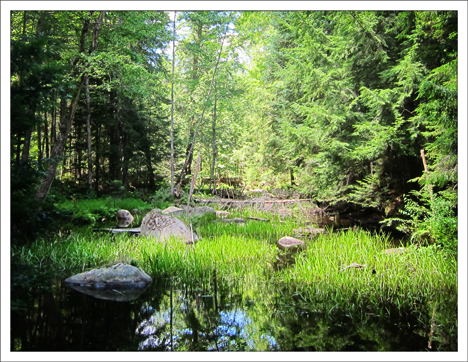 Blow-down on Barnum Brook (21 July 2012)
Blow-down on Barnum Brook (21 July 2012)
Adirondack Tree List
On 21 July 2012, VIC Naturalist Diane Minutilli led a nature walk focusing on Adirondack trees. The walk focused on 11 species of trees and one shrub – all typical of Adirondack mixed woods. We walked the .9-mile Barnum Brook trail, which offers a series of markers for each of these species. Some of the trees along the trail showed the effects of a strong storm the previous week.
Sugar Maple
Sugar Maple is the state tree of New York. This deciduous tree grows 50-70 feet tall, with a single trunk, and has a life span of 200-300 years. The yellowish green leaves, which turn orange or red in the autumn, have five lobes and pointed tips. The edges of the leaves are smooth, not saw-toothed. The bark is gray, smooth when young and scaly when the tree gets older. The seeds are the familiar “helicopters.”
American Beech
American Beech is a medium to large deciduous tree, with a short, thick single trunk. The light blue-gray bark is unusual, since it remains smooth even as the tree ages. The leaves are egg-shaped, with parallel veins ending in a tooth. Each leaf has a long pointed tip. The leaves turn brown in fall, but (unlike most deciduous trees) remain attached until toward the end of winter. The fruits of the tree are small, triangular nuts, surrounded by a bur. The buds are long, sharp, and pointed.
Bigtooth Aspen
Bigtooth Aspen is a deciduous tree, one of over forty species of poplar found in the northern hemisphere. It is relatively short-lived, with a life span of up to 100 years. Its name is derived from the large teeth on the oval leaves, which turn yellow in the fall. The bark of the Bigtooth Aspen is olive green, smooth when young, turning dark brown and deeply furrowed with age. The leaf stalk is flattened. The large leaves of the Bigtooth Aspen catch the slightest breeze, casing them to rustle and tremble in the wind.
Striped Maple
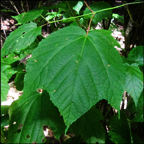 Striped Maple is a deciduous tree, whose bark (as implied by the name) is distinctly striped, making it easy to identify, even in winter. Striped Maple is an understory tree, growing about 10 to 30 feet tall in the shade of other larger trees. The leaves, which are often very large, have three lobes and are shaped like a goose foot. They turn yellow in the fall. White-tailed deer browse on the leaves during spring and summer, and also eat the twigs and saplings in the winter. Before nails, this wood of the Striped Maple was used for pegs in construction.
Striped Maple is a deciduous tree, whose bark (as implied by the name) is distinctly striped, making it easy to identify, even in winter. Striped Maple is an understory tree, growing about 10 to 30 feet tall in the shade of other larger trees. The leaves, which are often very large, have three lobes and are shaped like a goose foot. They turn yellow in the fall. White-tailed deer browse on the leaves during spring and summer, and also eat the twigs and saplings in the winter. Before nails, this wood of the Striped Maple was used for pegs in construction.
Red Spruce
The Red Spruce is a conifer and a member of the Pine family. It is a medium-sized tree, growing 50 to 70 feet tall with a single straight trunk. Its bark is reddish brown, thin with many small scales. The single needles are stiff and sharp, ½ to ¾ inch long. The small (.75 to 1.5 inches long) cones are green or purplish, turning reddish brown at maturity. This tree is said to favor nutrient-poor soils and can thrive in deep shade.
Eastern White Pine
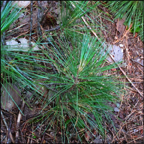 This large conifer is one of the signature trees of the Adirondacks. The Eastern White Pine is the largest eastern conifer, growing up to 125 feet tall, depending on the soil. This tree has clustered needles (five to a cluster). Because the tree grows higher than surrounding trees, it is subject to wind damage and the branches on the part of the tree that faces the winds often fall off. Each needle is three to five inches long and is soft and flexible. The long, thin needles seem to whisper in the breeze. The bark is gray to brown and has large broad scales as the tree ages. The cones are five inches long, with a pointed white tip. The long, straight trunks of the Eastern White Pine were used to make ship’s masts. This is one of the most important timber trees in the Northeast.
This large conifer is one of the signature trees of the Adirondacks. The Eastern White Pine is the largest eastern conifer, growing up to 125 feet tall, depending on the soil. This tree has clustered needles (five to a cluster). Because the tree grows higher than surrounding trees, it is subject to wind damage and the branches on the part of the tree that faces the winds often fall off. Each needle is three to five inches long and is soft and flexible. The long, thin needles seem to whisper in the breeze. The bark is gray to brown and has large broad scales as the tree ages. The cones are five inches long, with a pointed white tip. The long, straight trunks of the Eastern White Pine were used to make ship’s masts. This is one of the most important timber trees in the Northeast.
Red Maple
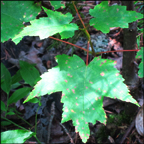 This deciduous Adirondack tree grows 40 to 60 feet tall, with a single trunk and a narrow, dense crown. The light green leaf of the Red Maple is lobed, with shallow notches between the lobes. The leaf, in contrast to that of the Sugar Maple, is saw-toothed. The leaves are smaller than those of the Sugar Maple and turn red to orange in autumn. The leaf stalk is red. The bark is smooth and gray when young, becoming scaly and darker with age. The seeds are small “helicopters” which drop in early June. The Red Maple prefers wet to moist soils and can often be seen growing along swamps or depressions that hold water.
This deciduous Adirondack tree grows 40 to 60 feet tall, with a single trunk and a narrow, dense crown. The light green leaf of the Red Maple is lobed, with shallow notches between the lobes. The leaf, in contrast to that of the Sugar Maple, is saw-toothed. The leaves are smaller than those of the Sugar Maple and turn red to orange in autumn. The leaf stalk is red. The bark is smooth and gray when young, becoming scaly and darker with age. The seeds are small “helicopters” which drop in early June. The Red Maple prefers wet to moist soils and can often be seen growing along swamps or depressions that hold water.
Balsam Fir
 This Adirondack conifer grows 50-75 feet tall in a tapering spire, with many horizontal branches from the ground up. The needles of the Balsam Fir are attached singly, with no stalks and rounded ends. The needles are shiny green above, with two silvery lengthwise lines or groves below. The bark is smooth with resin blisters. The cones, which are purple to green, grow upright in dense clusters near the top of the tree and are a favorite food of squirrels. This tree is well-known for its fragrant needles and is a popular Christmas tree because it holds its needles well after cutting. This tree is also called Canada Balsam or Eastern Fir.
This Adirondack conifer grows 50-75 feet tall in a tapering spire, with many horizontal branches from the ground up. The needles of the Balsam Fir are attached singly, with no stalks and rounded ends. The needles are shiny green above, with two silvery lengthwise lines or groves below. The bark is smooth with resin blisters. The cones, which are purple to green, grow upright in dense clusters near the top of the tree and are a favorite food of squirrels. This tree is well-known for its fragrant needles and is a popular Christmas tree because it holds its needles well after cutting. This tree is also called Canada Balsam or Eastern Fir.
Paper Birch
This deciduous Adirondack tree has chalky white, smooth bark with dark horizontal lines; the bark often peels in papery strips on older trees. The inner bark is a reddish color. The leaves, which are oval to triangular, with pointed tips and double-toothed edges, are dull green above and pale green on the underside. They turn yellow in the fall. This understory tree likes moist soil. This tree is also called the White Birch or Canoe Birch, the latter name a reference to the fact that native Americans used it to construct canoes, baskets and water containers.
Eastern Hemlock
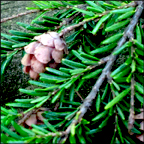 This Adirondack conifer is a member of the Pine family. It has short single needles arranged in two rows. The small cones are green, turning brown in maturity, and hang like tiny pendants. The bark is dark brown and deeply grooved; fresh cut bark shows purple streaks. The small holes in the trunk reflect the work of Yellow-bellied Sapsuckers. Eastern Hemlock like wet soils and are shade tolerant. The Eastern Hemlock is a very long-lived tree, with a life span of 600 years or more. This tree is also called the Canada Hemlock or Hemlock Spruce.
This Adirondack conifer is a member of the Pine family. It has short single needles arranged in two rows. The small cones are green, turning brown in maturity, and hang like tiny pendants. The bark is dark brown and deeply grooved; fresh cut bark shows purple streaks. The small holes in the trunk reflect the work of Yellow-bellied Sapsuckers. Eastern Hemlock like wet soils and are shade tolerant. The Eastern Hemlock is a very long-lived tree, with a life span of 600 years or more. This tree is also called the Canada Hemlock or Hemlock Spruce.
Hobblebush
Hobblebush, also called  Witch Hobble, is a woodland shrub common throughout the Adirondacks and the VIC property. The shrub, a member of the Viburnum genus, has pendulous branches that take root where they touch the ground, forming obstacles that trip (or hobble) passers-by – giving the plant its common name. Hobblebush has large heart-shaped, light green leaves. This plant blooms in May in flat-topped clusters of small white flowers. The flowers are followed by fruit which is scarlet when young and blue-black when ripe. The fall foliage is usually a deep wine red.
Witch Hobble, is a woodland shrub common throughout the Adirondacks and the VIC property. The shrub, a member of the Viburnum genus, has pendulous branches that take root where they touch the ground, forming obstacles that trip (or hobble) passers-by – giving the plant its common name. Hobblebush has large heart-shaped, light green leaves. This plant blooms in May in flat-topped clusters of small white flowers. The flowers are followed by fruit which is scarlet when young and blue-black when ripe. The fall foliage is usually a deep wine red.
Yellow Birch
This deciduous Adirondack tree grows up to 70 feet tall, with a single trunk and round irregular crown. In contrast to the white bark of the Paper Birch, the bark of the Yellow Birch is shiny yellow to bronze and peels in very thin curls. The bark becomes coarse and scaly with age. The leaves are oblong, long and pointed and saw toothed. Broken twigs of the Yellow Birch have a distinct wintergreen smell. The seedlings are a favorite food of the White-tailed Deer.
